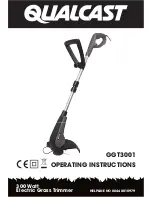
7
E N G L I S H
General
1. Consider work area environment
Do not expose the tool to rain. Do not use the
tool in damp or wet conditions. Keep the work
area well lit. Do not use the tool where there is
a risk of causing fire or explosion, i.e. in the
presence of flammable liquids and gases. Keep
the work area free from debris and obstacles.
2. Keep children away
Do not allow children, visitors or animals to
come near the work area or to touch the tool.
3. Store idle tools
When not in use, tools and batteries should be
stored in a dry place, out of reach of children.
4. Dress properly
Do not wear loose clothing or jewellery, as
these can be caught in moving parts. Preferably
wear working gloves and non-slip footwear
when working outdoors. Wear protective hair
covering to keep long hair out of the way.
5. Personal protection
Wear safety goggles and a face or dust mask
whenever the operations may produce dust or
flying particles. Wear ear protection whenever
the sound level seems uncomfortable.
6. Do not overreach
Keep proper footing and balance at all times.
7. Stay alert
Watch what you are doing. Use common sense.
Do not operate the tool when you are tired.
8. Use appropriate tool
The intended use is described in this
instruction manual. Do not force small tools or
attachments to do the job of a heavy-duty tool.
The tool will do the job better and safer at the
rate for which it was intended. The use of any
accessory or attachment or performance of any
operation with this tool other than those
recommended in this instruction manual may
present a risk of personal injury. Do not force
the tool.
9. Maintain tools with care
Keep cutting tools sharp and clean for better
and safer performance. Follow the instructions
for maintenance and changing accessories.
Keep handles and switches dry, clean and free
from oil and grease.
10. Check for damaged parts
Before using the tool, carefully check it for
damage to ensure that it will operate properly
and perform its intended function. Check for
misalignment and seizure of moving parts,
breakage of parts and any other conditions
that may affect its operation. Have any
defective parts repaired or replaced by an
authorised repair agent. Do not use the tool if
any part is defective. Never attempt any
repairs yourself.
11. Remove the battery
Remove the battery when the tool is not in
use, before changing any parts of the tool,
accessories or attachments and before
servicing.
12. Avoid unintentional starting
Do not carry the tool with a finger on the
on/off switch.
13. Do not abuse cord
Never carry the charger by its cord or pull it to
disconnect from the socket. Keep the cord
away from heat, oil and sharp edges.
Additional safety instructions for batteries and
chargers
Batteries
◆
Never attempt to open for any reason.
◆
Do not expose to water.
◆
Do not store in locations where the
temperature may exceed 40 °C.
◆
Charge only at ambient temperatures between
4 °C and 40 °C.
◆
Charge only using the charger provided with
the tool (see technical data).
◆
Before charging, make sure that the battery is
dry and clean.
◆
Use only the correct type of battery for the tool
(see technical data).
◆
When disposing of batteries, follow the
instructions given in the section “Protecting
the environment”.
◆
Under extreme conditions, battery leakage
may occur. When you notice liquid on the
battery, proceed as follows:
Summary of Contents for GTC2451
Page 1: ...1 www blackanddecker com ...
Page 3: ...3 9 8 7 10 6 7 4 5 3 2 1 A ...
Page 4: ...4 12 6 11 1 3 2 C B D1 D2 ...
Page 5: ...5 D4 D3 ...
Page 89: ...89 ...








































